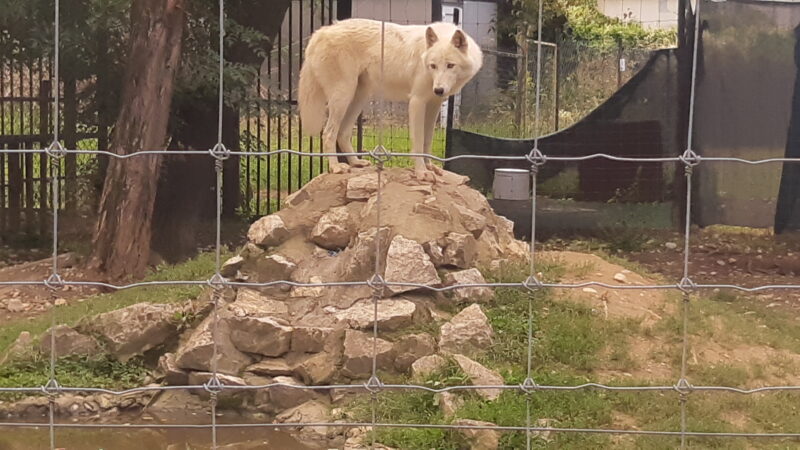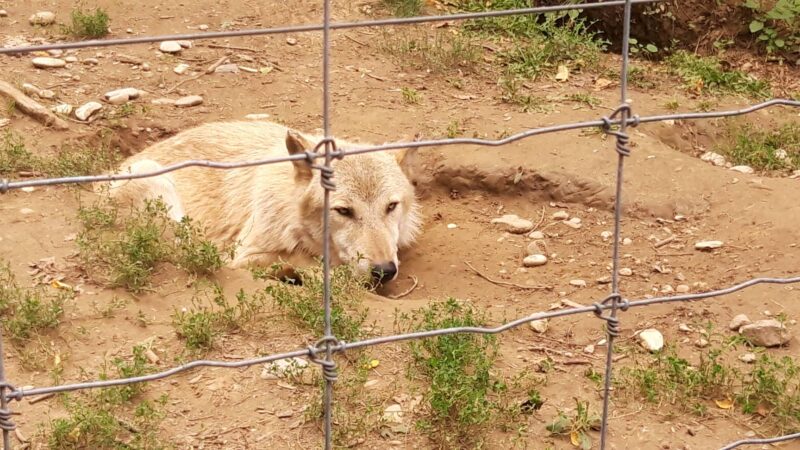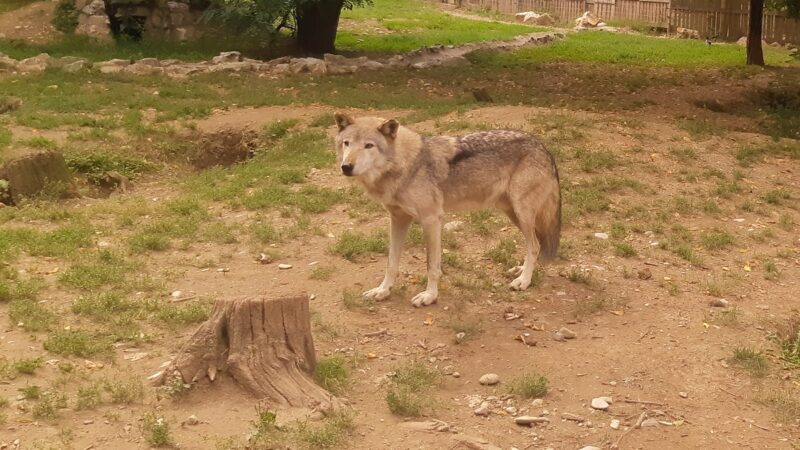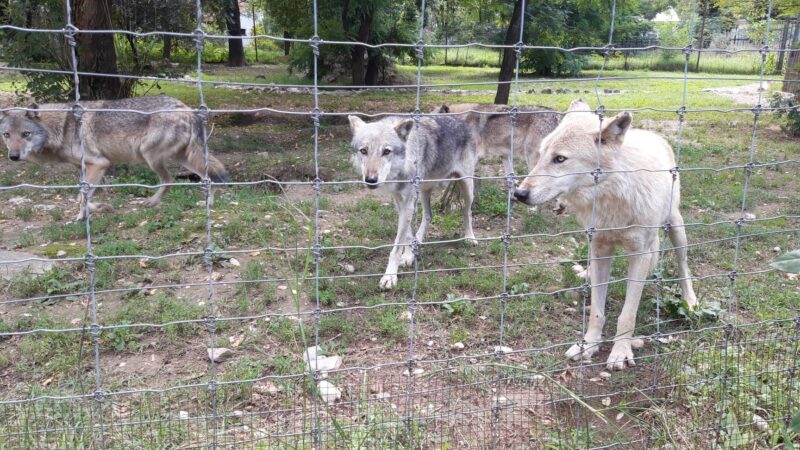This article is from a original report [en] by Meta.mk. This version is published here after modifications under a content-sharing agreement between Global Voices and the Metamorphosis Foundation.
In North Macedonia, the wolf (canis lupus) is widely considered a nuisance. It is regularly felled, despite its essential role in maintaining a healthy ecosystem. It is one of the three main predators that inhabit the mountains of the country, along with the bear and the Balkan lynx. But it is the least well protected of the three.
Hunters are encouraged to hunt and kill the animal, and even receive a bounty when they kill one. However, environmental defense associations warn of the decline of its population, which could have a devastating impact on the mountain ecosystem. The current population in North Macedonia is estimated at just over 400 wolves. In addition to being the targets of authorized hunting, they must face various threats, such as hybridization with dogs.
Under the current hunting law [mk] in North Macedonia, the wolf, but also the fox, the marten, the weasel, and many other animals, represent easy prey for hunters, because there is no rest period prohibiting their hunting. The Ministry of Agriculture has even introduced bounties for killing “dangerous” wild animals. Hunters earn approximately 50 euros [en] (calculated at the exchange rate on the date of the article) for each wolf killed.
“The law must be changed,” said Dime Melovski, of the Macedonian Ecological Societyin a statement for Meta.mk, “and wolf hunting must be regulated by partial bans, as its population in the country is in constant decline. »
Although permanent protection is not a good solution according to him, he stresses that the government must introduce hunting restriction periods. He suggests setting up quotas to limit hunting, calculated according to the precise number of wolves in the hunting areas. According to Melovski, more sophisticated counting methods should be used, generic counting for example, because the current number of wolves is most likely wrong; there is some overlap in numbers, as wolves live and feed in very large territories. He adds :
We are perhaps among the last countries in Europe where the wolf is considered a pest and the its killing is not limited, and there is a reward, moreover, which serves as an additional motivation for killing wolves, both for the hunters and for the cattle breeders.
We are probably one of the last countries in Europe where the wolf is considered harmful, where it is killed without restrictions, and where there is, beyond all that, a reward which motivates even more to kill wolves, both for hunters and breeders.
One of the main problems of wolf protection efforts, according to Melovski, is to fight against the open advertising for hunting tourism [mk], and the seduction of foreign hunters. We have to stop them immediately. The absence of any restrictions encourages the organization of hunting campaigns, because it is only in this country that foreign hunters can come and shoot a wolf.
North Macedonian wolves generally prefer a mountainous and forested habitat, although they occasionally venture into lowland agricultural areas around villages.

Along with the lynx and the bear, the wolf is a major predator in North Macedonia. Photo of a young wolf at Skopje Zoo, by Global Voices/Filip Stojanovski, CC BY 3.0.
According to Vojo Gogovski, State Councilor at the Ministry of Agriculture in charge of forests and hunting, the wolf population is stable at around 400 individuals. North Macedonia is home to the largest and oldest wolf population in Europe. The counts are regular, at least every ten years, in each hunting territory of the country. In a statement for Meta.mk, Gogovsky explained:
For big game and small game there is a methodology for collecting data on the quantity that is accepted everywhere in Europe and in our country. A count or estimate of the number can be made, and based on it, the annual growth dynamics are defined. If there is a need, in five years or shorter, the planning documents can be revised.
For small and big game, there is a population data collection methodology that is applied everywhere in Europe and in our country. The number can be counted or estimated, and on this basis annual growth trends are defined. If necessary, at five years or less, we can review the planning documents.
Of new hunting regulations [mk] are being prepared, including a draft law which has been in public consultation since April 2021. The published draft still lists the wolf as an unprotected wild animal, and authorizes night hunting and the use of searchlights. It also allows the Ministry of Agriculture to distribute rewards.
There was a time when the wolf was a protected species, but according to Gorovski, the population was out of control at that time. She attacked livestock, and was credited with many casualties. Although there was no requirement to tag cattle, these figures had probably been inflated because ranchers could receive compensation if the loss of an animal was caused by a wolf. He stated :
There is no one who cares more than us for the protection of the wolf. The real hunters take good care of animals. The population is stable, and that’s because we’re taking care of the game that is its food. But the number must be maintained at a certain level. So far, there has not been a case of the monetary reward being the motive for killing; instead, most often the motive has been the protection of the domestic livestock. I claim that there is no such thing as a classic wolf hunt.
No one cares more about protecting the wolf than ourselves. True hunters take good care of animals. The population is stable, and that’s because we take care of the game that is its food. But their number must remain under control at a certain level. So far, there have been no instances where the bounty has been the motivation to kill a wolf; instead, more often than not the goal is to protect livestock. I announce it: there is no traditional wolf hunt.
environmental organization Eko-svest [mk] (eco-awareness) recently called on World Wolf Day (August 13) for precautionary measures to ensure wolves stay in our forests, where they belong. According to conservationists, although modern life often leads to conflicts between humans and wolves, they are still necessary and invaluable in maintaining the balance of the ecosystem. Their predatory impact changes the behavior of other animals, it protects forests from pests, and even protects rivers from erosion and damage. Their statement [mk] said:
The wolf in this country is placed in the near threatened category (NT). The reason for this is that it is considered harmful wild animal, so commercial hunting is organized throughout the year, and, also new infrastructure projects are fragmenting its habitats. According to the official estimates, over 400 individuals live in our country, but its population is not regularly monitored.
In this country, the wolf is placed in the category of near threatened species (NT). This is explained because it is considered a dangerous wild animal, so commercial hunting campaigns are organized all year round; it can also be explained by infrastructure projects that fragment its habitat. According to official estimates, just over 400 individuals live in our country, but its population is not regularly monitored.

A wolf lying in a hole she dug in the enclosure of the Skopje zoo. Photo by Vasil Buraliev, used with permission.
On a global scale, the wolf is protected by three international conventions [en] : the Washington Convention (CITES – Convention on International Trade in Endangered Species of Wild Fauna and Flora); then Annexes II, IV, and V of the European Union Habitats Directive [en]. It is listed among the strictly protected species in appendix II of the Bern Convention.
L’International Union for Conservation of Nature (IUCN) classifies the wolf as the “least concern” in Europe, because even if it is threatened or vulnerable in certain countries on a national scale, it nevertheless develops on a continental scale both in number and in territory coverage. Nevertheless, wolf hunting remains authorized in many European countries that are not members of the European Union, such as Russia, Belarus, Ukraine, North Macedonia, and Albania. Wolves are also a tourist attraction in several countries, and regulated hunting is enforced in Finland, Norway, Lithuania, Latvia, Estonia, Bulgaria, Romania, and Slovakia.
We want to say thanks to the writer of this post for this amazing material
North Macedonia: the wolf targeted and killed
We have our social media profiles here and other related pages herehttps://nimblespirit.com/related-pages/


